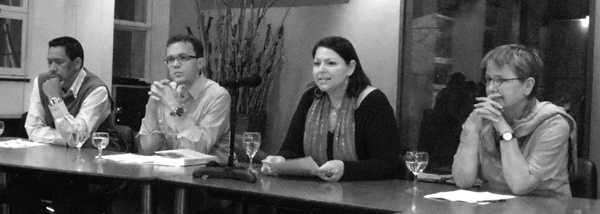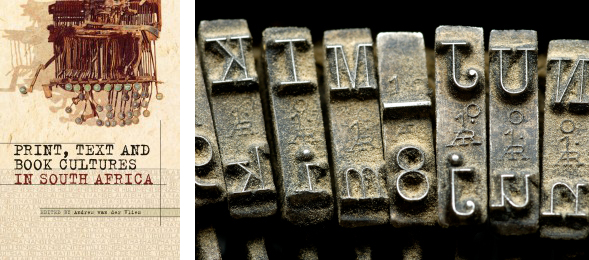
The panel in the WISER seminar room (From left to right): Archie Dick, Andrew van der Vlies, Ashlee Neser and Isabel Hofmeyr.
Launch of Print, Text and Book Cultures in South Africa edited by Andrew van der Vlies, WISER, Wits University, 12 September 2012.
LARA BUXBAUM
This year has seen the release of three edited academic volumes on South African literature: The Cambridge History of South African Literature, The Columbia Guide to South African Literature in English since 1945 and SA Lit Beyond 2000. On Wednesday night the launch of the latest addition, distinguished by its focus on book histories, was celebrated.
As the sun set over the city centre, visible through the windows of the seminar room, Ashlee Neser, researcher at WISER, welcomed us and introduced the book and the panel of three contributors. She suggested that Print, Text and Book Cultures in South Africa, unlike other collections, is interested in the “object of South African literature” and cited Roger Chartier (who was name checked several times in the proceedings): “Authors do not write books, they write texts which then become objects” and it is these objects – their production, circulation, reception, and interpretation – which is the focus of the current collection.
Neser claimed that the book itself is both provocative and productive in terms of the “conversations” it is sure to generate and the questions of “textual anthropology and reading practices” it raises. She praised the “contours and range of methodological” approaches on display in its pages as well as its “considerable and imaginative scope”. The mood was set for a series of original, collegial, generous and provocative interchanges.
Andrew van der Vlies, a senior lecturer at Queen Mary, London University, edited the book and is the author of several critical studies, notably the monograph South African Textual Cultures (2007). Van der Vlies acknowledged and thanked Wits Press and briefly described the genesis of the current collection and of his burgeoning interest in “book history”, which was nurtured by his supervisor at Oxford, Peter McDonald. Van der Vlies was influenced by Chartier’s interest in “books as material objects” as well as Robert Darnton’s model of “circuits of communication” and Don Mackenzie’s work on the “sociology of texts”.
He is interested in the “transnational lives that books that came to be called ‘South African’ lead” and how “the idea of South African literature is produced in and between borders”, giving the example of Alex La Guma’s novels which are published in Nigeria.
Van der Vlies insisted that his intention with this collection is to “try to set an agenda, rather than try to cover” a “field”. He was adamant that this is “not a national history of the book in South Africa” nor is it “an attempt to foreclose” debate but should rather be viewed as the “opening of a field”, as a “provocation”. He pre-empted any over-eager questions by acknowledging the existence of “holes” in the book – themselves provocations for further research.
The aim of this collection is therefore neither prescriptive nor authoritative. It suggests that “this is the kind of work that can be done, to ask the questions that need to be asked”. In this sense, the three chapters on J.M. Coetzee could be considered as a “model” of analysis, or ways of reading. This statement was a partial response to Neser’s initial urging of the audience to question the book’s extended focus on Coetzee. Audience members unfortunately declined to take the bait – on this or other provocations – in the short Q & A session.
Van der Vlies read the final few paragraphs of his introduction to the volume to emphasise the kind of intervention he envisions this book making, and to suggest future directions for study, in a country in which, shockingly “only 1% of the population are book buyers”.
Referring to Matt Cohen’s (2010) research, he argued that “we need a more nuanced and capacious account of how communication across languages in colonial spaces marked unevenly by orality and literacy has always relied simultaneously on multiple media” (40).
Van der Vlies concluded by identifying problems in the South African context: the “textbook crisis”, the state of literary production – especially in terms of the editing process and the flawed “agent structure” – and the fact that the “South African literary culture can sometimes appear defensive”. “So”, he ended, “that’s my provocation”.
Archie Dick, the second contributor present, is a professor in the Department of Information Science in the University of Pretoria and has published The Philosophy, Politics and Economics of Information (2002) and The Hidden History of South Africa’s Book and Reading Cultures (2012).
He was “flattered” to be involved in this project, especially as his discipline of librarianship is often not considered as “prominent a tributary to book history” as others. Clearly inspired and enthusiastic about his profession, he relayed his joy at the recent discovery of the papers of the short-lived South African Literary Society of 1824. These papers reveal a great deal about early attitudes to books and reading, especially the “materiality of the book” as “19 out of their 44 regulations” concerned the library. His personal interest is in how the “common readers”, in Virginia Woolf's terms, gained access to books and he is particularly intrigued by the “intended and unintended consequences of the schemes for the common reader” and how they “used reading to represent themselves”.

Furthermore, the “copying and circulation practices” in South Africa’s history are fascinating as are the “different ways of looking at how people use literary skills in surprising ways”. He attributes awareness of these diverse elements of book history to Isabel Hofmeyr’s influence.
Suggesting future directions for study, he posed the question of whether there could be a fictional “canon” in the liberation struggle. Sharing the results of his extensive research, he rattled off a list of books that were most popular on the different fronts of the struggle: in prisons, MK camps, and townships. Interestingly, and suggestive of different processes of identity formation, the texts read in exile were dominated by South African authors, whereas those on Robben Island were drawn predominantly from the canon of Western literature. In an amusing anecdote, he relates how Das Kapital was allowed into the Robben Island library because the censor dismissed it as “a book about money” which was thus permissible.
In response, Neser asked if he was aware that an online blogger had declared him their “latest intellectual crush”. Isabel Hofmeyr, the final speaker, enthused that she would “join the blogger’s fan club”. Hofmeyr is a Professor of African Literature at Wits and in Neser’s warm introduction was credited for “anticipating before the rest of us” trends in literary scholarship.
Hofmeyr spoke of her own interest in book history in terms of the relationship between the “inside” and “outside” of the book. In an admirable example of a concise précis, Hofmeyr drew on Leah Price’s work in How to do Things with Books in Victorian Britain (2012) to elaborate. She explained how two separate disciplines had arisen: literary studies, which is focused on the “inside” of the book, and book studies, whose analytical energies are outwardly directed. This “unfortunate division” is our intellectual inheritance and its consequence is that we “can never fully grasp the full affective power of the book”.
Price enquires after the “origin of this division” and in her reading of Victorian novels argues that the “inside” is “valorised” and the disembodied reading style associated with it – of losing yourself in the book, “of forgetting your own body and the body of the book” and reading continuously from beginning to end – is regarded as the “most virtuous”. Attention to the “outside of books” was thus deemed “vulgar”.
This reading style has come to be “hegemonic”. However “most reading across the globe is discontinuous” and fragmentary – “even in academia”, Hofmeyr said, to titters of laughter.
Price then draws a “distinction between the tract and the novel” which was “mapped onto social distinctions”. The former was “given out for free or thrust upon social inferiors” while the latter was “freely chosen” and thus “desirable”.
Although Price’s focus was not extended to “Empire”, Hofmeyr proposed that these distinctions could be fruitfully mapped onto the reading experiences of the “subjects of Imperial rule” who “were asked to occupy the impossible intersection” of the missionary tract and the western novel.
Linking this to “Archie’s [discussion of] reading in exile”, there is a kind of “crossover”, where “novels are treated as tracts”.
Hofmeyr concluded, the “legacy of these [Victorian] ideas are apparent today”. In any discussion on the state of reading in South Africa, the “virtuous model is the implicit reference point”. However, she suggested it might be more revealing to consider “discontinuous ways” of reading. The book being launched on his occasion, then, could be read in terms of this history, and it performs the “important service” of “reintegrating” the inside and outside of a “range of literary texts and how they play out in a postcolonial context”.
The conversation had already run over schedule, so question time was limited. Concerning the impact of the “metropolitan culture” and different reading communities, Van der Vlies responded that some contributors explore “what happens to books in different contexts” – “their fates say a great deal about those historical moments”. He also wondered if there is a “lingering inferiority complex” that sees South African novels only gaining publicity domestically if they are lauded in Europe, or Booker shortlisted, for example.
In response to a comment about the importing of books historically, Hofmeyr said a great deal of work had been done on these histories of book consumption in India, notably by Priya Joshi, and Australia, but there remained little work in this regard in South Africa – thus suggesting a research project for a student.
On this note, it is a great pity that there were so few students present for an inspiring conversation which drew attention to multiple avenues of invigorating and refreshing research.
As a material object, Print, Text and Book Cultures,is undeniably enticing, feels substantial clutched in one’s hand and is beautifully produced – I hope I can safely say that without appearing vulgar – with the two images of Willem Boshoff artworks that adorn the cover: Death of a Typewriter and Abamfusa Lawu. Many audience members seemed to agree as they took advantage of the launch night discount to purchase a copy. It will be no doubt prove interesting to track the reception of this book and any ripples it makes in the academy.
Capetonians will be able to engage in a conversation around these issues at the launch of the book at Open Book festival on 21 September 10:00-11:00 at the Fugard Ground.
 SLiPStellenbosch Literary Project
SLiPStellenbosch Literary Project